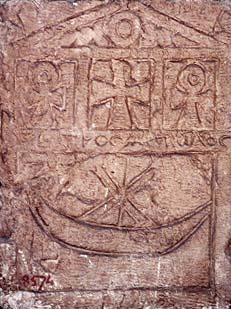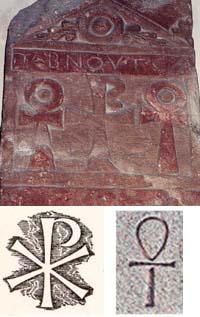

Crux Ansata
Coptic Museum, Cairo


|
Crux AnsataCoptic Museum, Cairo |
These Coptic funerary reliefs (5th-6th century AD) illustrate the transition in Egypt from traditional Egypto-Roman religion to Christianity. As such, they display transitional forms and symbols belonging to both religious systems. The overall interpretation of the reliefs is "Eternal life in Christ."
The reliefs (upper two photos) each show a pair of ankhs flanking a central Greek cross. But the ankhs are really crosses, and the central cross is really a Chi-Rho! (The "standard" forms of the Chi-Rho and ankh are shown in the two lower right photos for comparison.)
The "ankh cross" appropriated the Egyptian ankh (hieroglyph and symbol of life) into a form of the Christian cross. Its symbolism combines the idea of eternal life with the idea of Christ's redemption. The ankh cross is also called crux ansata, eyed cross, or handled cross, and is technically described as an "Egyptian" (tau, or T-shaped) cross with an upper loop.
The Chi-Rho, between the paired ankh crosses, is a form of Christ's monogram where the Chi or X-shaped St. Andrew's cross has been replaced by a large Greek cross. The only remainder of the Rho is a small P-shaped "handle" at the top of the cross. The end result is a Chi-Rho with strong visual resemblance and symbolic connection both to the Greek cross and to the ankh cross. The arrangement of three crosses recalls the crucifixion scene on Golgotha, where Christ was crucified between two thieves.
The circular heads of the ankh crosses display the hieroglyph for Re/Helios, the sun disk (Sol Invictus). This form of the ankh first appears in Amarna art, where the sun disk is the Aten. But here, the pagan sun-god has been appropriated into a Christian symbol, as tau-cross plus Re. This might be read as "Christ, the light of the world" (Lux Mundi). In identifying Re/Helios with Christ, one passes symbolically from pagan (Life in Re) to Christian (Life in Christ) faith and belief.
The reliefs present an amalgamation of Christian and Egypto-Roman (specifically, Isis) funerary cult. The name of the deceased is carved beneath the Chi-Rho. The reliefs are cut in the form of a traditional Roman shrine. They are surmounted by a pediment which contains paired snakes (Egypto-Roman symbols of the underworld) flanking a stylized sun-disk representing Re/Helios/Christ.
The boat in the left relief suggests Charon's boat which ferried dead souls to Hades, the Isis boat which towed the dismembered Osiris' barque along the Nile, and the cosmic boat which carried the deceased with Re through the underworld at night. The boat is also a symbol of the Christian Church: Jonah and the Whale, Christ walking on the water of the Sea of Galilee, and Christ's calling St. Peter and Andrew to be "fishers of men." More prosaically, the deceased might have been a sailor, boatwright, or fisherman.

|

|

|